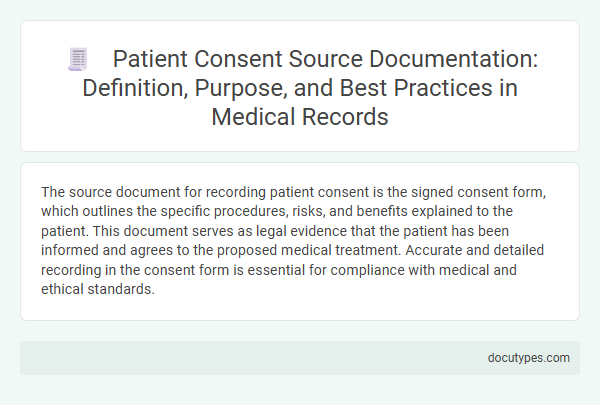The source document for recording patient consent is the signed consent form, which outlines the specific procedures, risks, and benefits explained to the patient. This document serves as legal evidence that the patient has been informed and agrees to the proposed medical treatment. Accurate and detailed recording in the consent form is essential for compliance with medical and ethical standards.
Introduction to Patient Consent Source Documentation
The source document for recording patient consent is essential in medical practice to ensure legal and ethical standards are met. Understanding the importance of accurate documentation helps protect both the patient and the healthcare provider.
- Consent Form - This is the primary document where patient consent is formally recorded and signed before any procedure.
- Medical Records - Detailed notes in the patient's file often include consent information and discussions about risks and benefits.
- Electronic Health Records (EHR) - Digital systems capture and store consent documentation securely for easy access and verification.
Your acknowledgment of consent through these source documents supports transparent and responsible medical care.
Definition of Consent Source Documentation in Medical Records
| Term | Consent Source Documentation |
|---|---|
| Definition | The original medical record or physical document that provides evidence of a patient's informed consent for medical treatment, procedures, or participation in research. |
| Purpose | To confirm that the patient has been adequately informed about the risks, benefits, and alternatives before agreeing to a medical intervention. |
| Common Forms | Signed consent forms, consent notes in medical charts, electronic consent records, and audio or video recordings in some cases. |
| Location in Medical Records | Typically stored within the patient's clinical documentation section or consent documentation folder of the medical record. |
| Legal Relevance | Acts as critical evidence in legal and regulatory contexts to validate that informed consent was obtained according to medical and ethical standards. |
Importance and Purpose of Documenting Patient Consent
What is the source document for recording patient consent? The source document for recording patient consent is the signed consent form, which serves as the primary record of a patient's agreement to a medical procedure or treatment. Documenting patient consent is crucial for legal protection, ensuring that you understand and agree to the risks and benefits involved in your care.
Legal and Ethical Foundations of Consent Documentation
The source document for recording patient consent is the informed consent form, which details the patient's agreement to undergo medical treatment after being fully informed of the risks, benefits, and alternatives. This form serves as a legal record ensuring that consent has been properly obtained in accordance with healthcare regulations.
Legal foundations require that the consent documentation be clear, comprehensive, and signed before any procedure begins, protecting both the patient and healthcare provider. Ethical standards emphasize transparency and respect for patient autonomy, making accurate consent records essential for trustworthy medical practice.
Types of Patient Consent in Healthcare Settings
The source document for recording patient consent is a critical record that validates a patient's agreement to medical procedures. It serves as a legal and ethical safeguard in healthcare settings.
- Informed Consent Form - A detailed document outlining the risks, benefits, and alternatives of a treatment, ensuring the patient's voluntary agreement.
- Implied Consent - Consent inferred from a patient's actions or the clinical situation when explicit consent is not feasible.
- Verbal Consent - An oral agreement recorded by healthcare providers, often used in non-invasive or routine procedures.
Essential Elements of Valid Consent Documentation
The source document for recording patient consent is typically the signed consent form, which outlines the procedures, risks, and benefits explained to the patient. Essential elements of valid consent documentation include clear identification of the patient, detailed description of the treatment or procedure, and the date and signature of the patient or their legal representative. You must ensure that the consent form is accurately completed and stored in the patient's medical record to maintain legal and ethical standards.
Best Practices for Recording and Storing Consent Forms
The source document for recording patient consent is the signed consent form, which serves as a legal record confirming that the patient has been informed about the procedure and agrees to it. This document must clearly outline the risks, benefits, and alternatives discussed with the patient.
Best practices for recording consent include obtaining the patient's signature prior to treatment and ensuring the form is detailed and unambiguous. Consent forms should be securely stored in the patient's medical record, preferably in electronic health record (EHR) systems that provide audit trails and easy retrieval.
Common Challenges in Consent Source Documentation
The source document for recording patient consent is a critical element in medical records, ensuring legal and ethical compliance. Understanding common challenges in consent source documentation helps improve accuracy and patient trust.
- Incomplete Documentation - Missing signatures or dates can render the consent invalid and complicate legal verification.
- Ambiguous Terminology - Vague language in the consent form may lead to misunderstandings about the treatment or procedure.
- Inconsistent Record Keeping - Variability in how consent is recorded across departments causes difficulty in retrieving and verifying patient agreements.
Strategies for Ensuring Compliance and Accuracy
The source document for recording patient consent is the signed consent form, which serves as a legal and ethical record of the patient's agreement to the proposed medical treatment or procedure. Accurate documentation in this form is crucial for compliance with regulatory standards and patient safety protocols.
Strategies for ensuring compliance and accuracy include using standardized consent forms tailored to specific procedures, regularly training healthcare staff on proper documentation practices, and implementing electronic health records (EHR) systems with built-in consent verification features. Verification processes such as patient identity confirmation and clear communication of procedure risks and benefits enhance the validity of consent. Routine audits and quality checks of consent documentation further maintain regulatory compliance and reduce legal risks.
What Is the Source Document for Recording Patient Consent? Infographic

